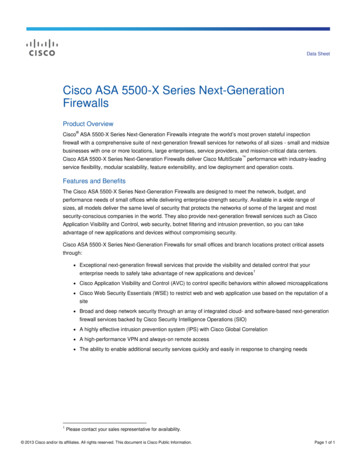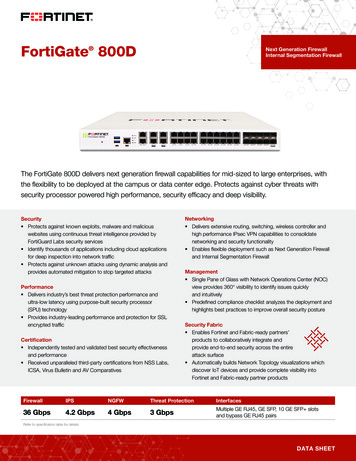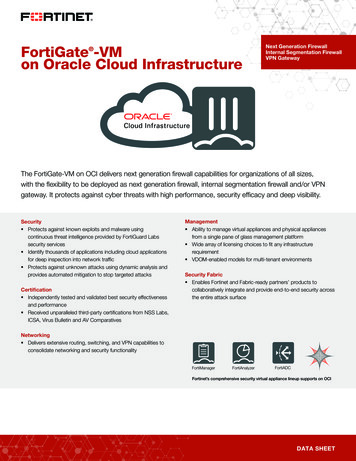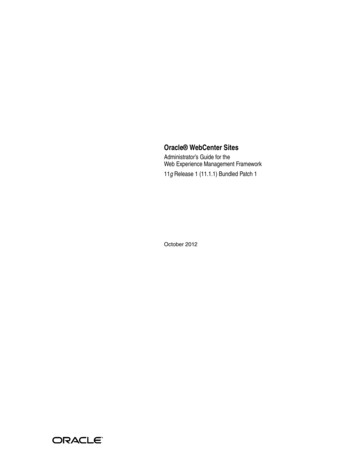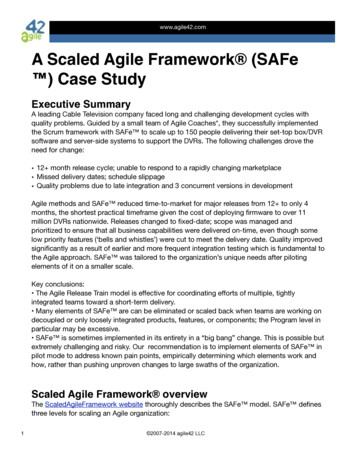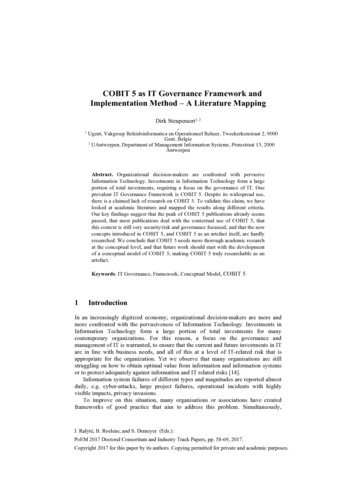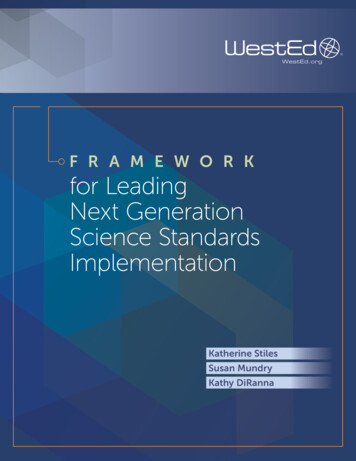
Transcription
F R A M E W O R Kfor LeadingNext GenerationScience StandardsImplementationKatherine StilesSusan MundryKathy DiRanna
Copyright 2017 WestEd. All rights reserved.Suggested citation: Stiles, K., Mundry, S., & DiRanna, K. (2017). Framework for Leading Next GenerationScience Standards Implementation. San Francisco: WestEd.This publication was made possible by a grant from Carnegie Corporation of New York: GrantNumber G-16-53891. The statements made and views expressed are solely the responsibility ofthe authors.
AcknowledgmentsDevelopment of the Framework for Leading Next Generation Science Standards Implementation was a collaborative effort by a group of highly experienced science education leaders and WestEd staff. Wewish to recognize and thank Jim Short, Program Director for Leadership and Teaching to AdvanceLearning at the Carnegie Corporation of New York, for providing the financial support for this work andfor lending his expertise to the development and refinement of the framework. The project benefittedenormously from the guidance and collaboration of the project design team and Next Generation ScienceStandards (NGSS) leadership experts, including:\\ Juan-Carlos Aguilar, Georgia Departmentof Education\\ Aneesha Badrinarayan, Achieve\\ Jody Bintz, Biological Sciences CurriculumStudy (BSCS)\\ Ellen Ebert, Washington Office of theSuperintendent of Public Instruction\\ Susan Gomez Zwiep, California StateUniversity, Long Beach\\ Trevor Greene, Highline School District,Washington\\ Mary Gromko, National ScienceTeachers Association\\ Tobias Jacoby, District of ColumbiaPublic Schools\\ Carolyn Landel, Charles A. Dana Center,University of Texas, Austin\\ Thomas (TJ) McKenna, ConnecticutScience Center\\ Tiffany Neill, Council of State ScienceSupervisors and Oklahoma Departmentof Education\\ Lee Ann Nickerson, Jefferson CountyPublic Schools, Kentucky\\ Pamela Pelletier, Boston Public Schools\\ Keri Randolph, National ScienceEducation Leadership Associationand Hamilton County Department ofEducation, Tennessee\\ Lynn Rankin, The Exploratorium,San Francisco\\ Susan Ritchie, Vista Unified School Districtand Project Director in the CaliforniaNGSS K–8 Early Implementation Initiative\\ Jeffrey Rozelle, Knowles ScienceTeaching Foundation\\ John Spiegel, San Diego, California CountyOffice of EducationWe also thank the science education leaders in California and Washington who participated in i nterviews to contribute examples of the essential actions needed to lead the implementation of theNGSS at the classroom, school, district, regional, and state levels. Thanks to Deborah Tucker for conducting interviews of California leaders and for her thorough review of the product. We are gratefulto our WestEd colleagues for their contributions to this work, including Claire Morgan who conductedthe review of the literature on science education leadership to inform this work; Kathy Dunne, for herthoughtful review and feedback; and to Colleen Abreu, Julie Colton, and Morgan Weiss who supportedthe project’s meetings. Our Communications team at WestEd greatly contributed to the conceptualization of the framework and the words on the page, including Fredrika Baer, Rosemary De La Torre,Ricky Herzog, Michael Medina, and Noel White.Framework for Leading NGSS Implementationi
ContentsAcknowledgmentsiIntroduction1The Development of the Framework for Leading Next GenerationScience Standards Implementation.2Values Shared by the Developers of the Framework. 3Suggestions for Engaging with the Framework. 5Overview of the Framework7Domain 1: Leadership Knowledge11NGSS and the Innovations in NGSS. 13Equity and Access for All Learners. 15Instructional Materials, Curriculum, and Assessment. 16Professional Learning . 18Systems Change . 19Continuous Improvement. 20Domain 2: Critical Actions22Aligning Policies. 24Allocating Funding. 25Assessing the System. 26Building a Shared Vision. 28Designing and Implementing Professional Learning for Teachersand Leaders . 29Developing Communication Strategies. 30Engaging Families and Key Stakeholders. 32Focusing on Equity and Accessibility. 33Forming Implementation Teams. 34Selecting, Adopting, Developing, and Aligning Curriculum,Instructional Materials, and Assessments. 36Using Data and Research to Monitor and Improve. 37Framework for Leading NGSS Implementationiii
Domain 3: Impacting NGSS Teaching and Learning39System Drivers. 41Domain 4: Sustaining Implementation of NGSS44People. 45Policies. 47Processes. 48Practices. 49Conclusion50Resources to Support Leaders51References57List of FiguresFigure 1. Framework for Leading Next Generation ScienceStandards Implementation. 7Figure 1.1. Leadership Knowledge. 11Figure 1.2. Critical Actions. 22Figure 1.3. Impacting NGSS Teaching and Learning. 39Figure 1.4. Sustaining Implementation of NGSS. 44Framework for Leading NGSS Implementationiv
IntroductionThe innovations in the Next Generation Science Standards (NGSS; NGSS LeadStates, 2013a) require shifts in science teaching and learning that are differentfrom the approaches called for in prior science education standards (Bybee,2015; NRC, 2012; Reiser, 2013). These innovations, or conceptual shifts, reflect anew vision for K–12 science education and include:\\ Science learning that is three-dimensional, connecting disciplinary coreideas (DCIs), science and engineering practices (SEPs), and crosscuttingconcepts (CCCs).\\ Student engagement in explaining phenomena and designing solutions.\\ Learning experiences that connect engineering design and the nature ofscience with the three dimensions of the NGSS.\\ Coherent progressions of SEPs, DCIs, and CCCs from kindergarten tohigh school.\\ Connections made between science, English language arts, and m athematics. (Bybee, 2015; NGSS Lead States, 2013b, pp. 1–4)As of spring 2017, 18 states plus the District of Columbia have adopted the NGSSas their state science education standards, and 15 states have adapted theirstate standards to align with the Framework for K–12 Science Education (NRC,2012) and the NGSS. In addition, six states are developing new state scienceeducation standards based on the NGSS, and numerous school districts areeither adopting or adapting the NGSS. The implications for the students in ourcountry are impressive — as of 2017, more than 50 percent of all students in theUnited States will be engaged in science learning that reflects the innovationsand vision of the NGSS (Bybee & Chopyak, 2017).The innovations of these standards pose new challenges for teachers andstudents, as well as for educators charged with leading the implementationof the new standards. Promoting science achievement, access, and equity forall learners that align with the new vision requires that states, districts, andschools have the leadership to guide the implementation of new standards. Theprimary role of these leaders will be to support educators in learning the standards and shifting their curriculum, instruction, and assessment practices.They will also need to address and overcome significant challenges to ensuring that all students have guaranteed and equitable access to rigorous standards-based curriculum and teachers who use standards effectively.Framework for Leading NGSS ImplementationIntroduction1
Unlike in previous science education reform initiatives, the innovations in the NGSSnecessitate significant transformations and shifts in practice. For example, the NGSSrequire shifts in what is taught, how it is taught, and how students engage in learning.In turn, making these shifts demands ample and sustained support and leadership.Implementation of the NGSS will require champions at the state and local levels whoclearly understand the vision of the NGSS and the innovations called for and who havethe capacity to expand the commitment to the NGSS among key stakeholders. Stateleaders will need to make the policy environment fertile for these new standards totake hold. Local leaders must learn to create strong professional learning systems thatbuild the capacity of educators to transform science teaching and learning and createand scale up the use of NGSS instructional materials.The Developmentof the Frameworkfor LeadingNext GenerationScience StandardsImplementationIn response to the need to develop leaders to guide the implementation of the NGSS,the Carnegie Corporation of New York provided funding to WestEd to develop a framework that defines the leadership knowledge and actions needed to effectively implement the NGSS. The development of the framework entailed completing a review of theliterature to identify the leadership knowledge and actions necessary for implementing new standards; convening an NGSS Leadership Summit with 21 national scienceeducation experts who have been implementing the NGSS in states and districts; andconducting 23 interviews with leaders at all levels of the system in California andWashington to gather voices from the field (many of which are included in quotationsthroughout this framework document). The Framework for Leading Next GenerationScience Standards Implementation is a synthesis of information gathered from all ofthese activities.One key learning from the project’s review of the literature and work with national science education experts is the critical importance of situating the leadershipfor NGSS implementation within the overall educational system. For example, theNational Science Teachers Association’s (NSTA’s) position statement on NGSS implementation reflects the nature of the systemic changes needed, stating that “achievingthe goals of the NGSS will take a long-term systemic effort that requires significantchanges in instruction, curriculum, assessment, teacher preparation and professionaldevelopment, accompanied by extensive financial, administrative, and public support.It will also depend on all stakeholders at the local, district, and state level assuming a shared and collaborative responsibility for helping realize the goals of NGSS”(NSTA, 2016, p. 2).In addition, the project identified the organizations, documents, and resources that science education leaders are accessing to support their strategic implementationof the NGSS and NGSS-aligned standards, such as the documents available throughAchieve, NSTA, the National Academies, the National Association of State Boards ofEducation, and several states’ websites. There are a multitude of documents available to leaders to inform and guide their strategic planning and implementation(e.g., Next Generation Science Standards District Implementation Workbook [Achieve,2017]). Throughout the Framework for Leading Next Generation Science StandardsFramework for Leading NGSS ImplementationIntroduction2
Implementation, we provide links to many of these resources to guide leaders in theirdevelopment of plans to implement the NGSS.The literature review and analyses of several resources on education leadership provided a wealth of information regarding the foundational knowledge that leaders needin order to guide and lead educational improvements, including the implementation ofstandards. However, no guidance was found regarding what knowledge is needed byleaders in order to drive the transformations that are required by the implementationof the NGSS, let alone how such knowledge would be developed. While leaders musthave a deep understanding of the standards, that knowledge alone falls short of whatleaders need to know and be able to do to support educators in making the necessaryshifts in teaching, learning, and assessing that the NGSS requires.In response to this gap in the literature, project leaders convened national scienceeducation and NGSS leaders in a summit to contribute to the identification of the foundational knowledge needed to lead the implementation of the NGSS. Further, projectleaders conducted in-depth interviews with science education leaders in two statesthat have been implementing the NGSS for several years.Through this process, six foundational knowledge areas were identified as essential in supporting leaders to coherently and systematically implement the NGSS.These knowledge areas form the Leadership Knowledge domain of the framework.Additionally, project leaders identified three other domains for the successful implementation of the NGSS: Critical Actions, Impacting NGSS Teaching and Learning, andSustaining Implementation of NGSS. These four domains have been developed into theFramework for Leading Next Generation Science Standards Implementation. The framework is intended to fill a gap by focusing on what leaders need to know and do to guideand sustain the implementation of the NGSS. The framework is graphically represented and described in detail in the next section.Values Shared bythe Developers ofthe FrameworkIn the NGSS Leadership Summit, science education experts and project staff were convened to develop this framework. We began by examining and discussing the beliefsand values we share that guide our work in science education. Through these discussions, we identified the following values and beliefs that underlie the Framework forLeading Next Generation Science Standards Implementation.1.Framework for Leading NGSS ImplementationEquity for all students is fundamental in science education. All students shouldhave access to an education that prepares them to be successful and to becomelifelong learners, including being producers and consumers of scientificinformation. All students have the capacity to succeed and thrive if given theopportunities to fully engage with the innovations in the NGSS in a learningenvironment that is student-centered where they are provided with equitable,engaging, rigorous, and coherent opportunities to explore phenomena and learnscience relevant to their lives. Ensuring equitable access requires educators tocreate the cultural and local relevance for students to engage in the practicesand to understand the ideas of science. Leaders and educators, therefore, mustrecognize areas where inequity exists and find solutions to address the inequity.Introduction3
2. Leadership is essential for guiding science education improvements and implementing the NGSS. Leaders need to engage in effective leadership practices, work collaboratively across levels of the system, and participate in professional learningexperiences to deepen their knowledge and capacity. Leaders working togetherto achieve sustained implementation of the NGSS need to share a commonvision, develop a common language, and understand the roles and responsibilities that each leader brings to the work. It is essential that leaders develop deepfluency in the language and concepts of the NGSS (NGSS Lead States, 2013a), theNGSS appendices (NGSS Lead States, 2013b), and the Framework for K–12 ScienceEducation (NRC, 2012).3. Engaging in the three dimensions of learning science is foundational for achievingthe vision of the NGSS. Science is both a body of knowledge and a way of knowingabout the natural world. Teachers and students need to approach the learningof science as scientists. Learners should have opportunities to learn by activelyengaging in the science and engineering practices, making sense of theirobservations through generating explanations, and thinking critically. Learnersshould also have opportunities to learn by using the crosscutting conceptsthat set the context for asking the right questions in order to be productive inproblem-solving. Those questions are essential to building strong knowledgestructures. The diverse knowledge and skills that learners bring as members ofdifferent cultural groups provide rich perspectives and are assets upon whichnew understandings can be built. Understanding science and engineeringcontent and practices provides agency and affordances that are strengthened bydiverse ideas and perspectives.4. Effective teacher and leader professional learning is imperative. All educatorsand leaders should have opportunities to engage in high-quality professionallearning that deepens their knowledge and builds their capacity. Ensuringequitable opportunities for professional learning requires recognizing andidentifying where inequities exist, such as teachers who live in remote or ruralareas with little access to some types of professional learning and potentiallylimited internet access. Leaders who design, implement, facilitate, and evaluateprofessional learning for others need to understand adult learning theories,enact the Standards for Professional Learning (Learning Forward, 2011), and haveopportunities to develop as facilitators.5. Building capacity, engaging in networks, and collaborating are essential for sustaining the implementation of the NGSS. The relationships that are built as a resultof collaboration, communication, and sharing of knowledge are foundationalto the NGSS implementation process. Building communities of practice amongteachers and among leaders can contribute to sharing the knowledge that theyare generating and the resources that they are developing, and contributes tobuilding the human capital needed to implement the NGSS. Collaborating andengaging with key stakeholders, both nationally and in local contexts, contributes to building capacity for NGSS implementation.6. Both understanding and leading the change process for individuals and organizations are fundamental to implementing the NGSS. Change management requiresknowledge of the change process and requires differentiated strategies forpeople who have varying comfort levels with change. Leading the kind ofchanges that are driven by the innovations in the NGSS requires ensuring thatpeople and organizations receive the ongoing support to enable them to makeFramework for Leading NGSS ImplementationIntroduction4
changes in practice over time. For NGSS implementation to be successful, alleducators and leaders will need to be drivers of change.7.Suggestions forEngaging withthe FrameworkThe implementation of the NGSS needs to be systemic and coherent. Science education should not exist in a vacuum, nor should the learning of science be isolatedfrom other disciplines. Leaders need to consider ways to align and integratescience with the learning of other subjects. Science learning can also occuranywhere and outside of school hours. In order to transform science education,leaders need to involve and consider the many contexts for science learning,including the community and informal environments that engage students andtheir families in learning science.The purpose of the Framework for Leading Next Generation Science Standards Implementation is to provide a comprehensive vision of the leadership knowledge necessary andthe critical actions that need to be taken to plan for and implement the NGSS. Depending upon your leadership role, the framework can be used in a variety of ways to informpolicy and practice. Below, we identify potential uses of the framework for state and localleaders and for those who develop leaders focused on the implementation of the NGSS.For state and local leaders, we suggest the following uses of the framework:\\ Use the framework to inform your initial NGSS planning, or to reflect on andpossibly revise existing NGSS implementation plans.\\ Review the descriptions of the leadership knowledge areas and engage in aself-assessment to identify your strengths and gaps in knowledge for planning,implementing, and sustaining the NGSS. Consider which areas you may want tolearn more about in order to enhance your leadership knowledge.\\ Share the framework with the team or colleagues you are working with toplan NGSS implementation. Use the framework to create a shared vision of theleadership knowledge that you all need, the critical actions you will need totake, the system drivers to influence, and actions and data needed to supportsustainability. Discuss as a team where you have strengths and what you wouldlike to learn.\\ Use the framework to develop state education agency (SEA) guidance documents for schools and districts to use in the implementation of the NGSS as wellas for the development of requests for proposals around science education andthe assessment of proposals from local education agencies (LEAs).\\ Engage SEA colleagues from other states in deepening their understanding ofthe framework and how its use might spark cross-state collaboration aroundthe implementation of the NGSS. Similarly, convene colleagues from other LEAsto collaboratively engage with the framework as a catalyst for cross-districtnetworking.\\ Present and discuss the framework at state and regional science coordinators’meetings to build capacity for leading the NGSS.Framework for Leading NGSS ImplementationIntroduction5
For developers of leaders, we suggest the following uses of the framework:\\ Use the framework as a guideline for developing course curricula for leaders inthe six foundational knowledge areas identified in Domain 1 of the framework.\\ Engage current leaders with the framework as a tool to reflect on their knowledge and actions and to consider ways to refine what they know and do to leadthe implementation of the NGSS.\\ Engage new leaders in assessing their understanding of the leadership knowledge and in setting learning goals for themselves.\\ Teach new leaders to understand the system drivers that they must influence orconsider in order to enact the NGSS in the classroom.\\ Consider the four domains of the framework in designing and implementingprofessional learning opportunities for leaders around NGSS implementation.Framework for Leading NGSS ImplementationIntroduction6
Overview ofthe FrameworkFigure 1. Framework for Leading Next Generation Science Standards ImplementationFramework for Leading NGSS IM ONTPR INOVREFLECTPR LUTE CTIRI ONAL AS LStandardsRST AIN M& EACHERSFramework for Leading NGSS DENTSFundingImTIACPRSEM ESTSY ANGCHOFEA ESRN SIOIN NALGSustainingImplementationof NGSSEM shipKnowledgeSSEEPLEOUS TUO ENEMDOngNGSS Teaching andaLerningOverview of the Framework7
The Framework for Leading Next Generation Science Standards Implementation answersthe question: What do leaders need to know and be able to do in order to lead the implementation of the Next Generation Science Standards (NGSS)? It provides a vision of thefour major domains that leaders focus on as they lead the implementation of the NGSS.As discussed earlier, the innovations in the NGSS require significant transformations andshifts in practice. For example, students will be engaged in three-dimensional learning,explaining phenomena and designing solutions, and developing their science knowledgeand understanding through a progression of learning from kindergarten to high school.These innovations, or conceptual shifts, reflect a new vision for K–12 s cience education.The shift in what and how students engage with and learn science has significantimplications for the instructional shifts that also need to occur to ensure studentlearning. For many teachers, the shifts will demand using a variety of instructionalstrategies and approaches that require additional professional learning and coaching support. At the same time, other aspects of the system will need to be aligned tosupport these transformations in teaching and learning. It is imperative to look at theteaching conditions necessary for successful implementation of the NGSS. For example, professional learning and evaluation systems will need to reflect what teachersneed to know and be able to do to effectively implement the NGSS. School leaders willneed to examine the structure of the school day to ensure adequate time is availablefor science teaching and learning. Developing and supporting teacher leaders to ensuresustainable coordination and implementation of the NGSS will also be essential.These transformational changes in practice require ample and sustained support fromleaders. A fundamental concept within the framework is that leadership for the NGSSrequires leaders to develop and use new knowledge unique to the NGSS. Further, theframework assumes that possessing this leadership knowledge is a necessary ingredient for leaders to be able to carry out the critical actions needed for NGSS implementation. The framework lays out the knowledge and critical actions that leaders need tosuccessfully implement the NGSS.I’m sobered by the complexity of NGSS implementation and“ energizedby the potential. There’s a lot of value in having the threedimensions and that has caused us to be much more focused on talkand modeling, more so than when we were inquiry focused. We aremore focused on various ways of coming to make meaning of phenomena, and argumentation from evidence is more emphasized. Thesepractices are an important aspect of doing inquiry that the NGSSemphasizes, and it’s all about making sense with intertwining theDCIs. The focus is on modeling and argumentation as two specificways to communicate about the phenomena. Inquiry was always aboutsense-making, but the process skills didn’t have the same impact.Now, it’s integrated in a way that it’s part of the process. When you seethe young children develop their models and explain them to you, thethinking and the reasoning that is going on is so powerful. It’s inspiring. How do I get my kids there? How do I get my kids to do the thinking and the reasoning? It’s articulated well in the NGSS.”— Informal Science Education Institution LeaderFramework for Leading NGSS ImplementationOverview of the Framework8
The framework starts with Domain 1: Leadership Knowledge. This domain consists ofsix foundational knowledge areas that leaders need to know and understand in order toprepare them to lead NGSS implementation:\\ NGSS and the Innovations in NGSS\\ Equity and Access for All Learners\\ Instructional Materials, Curriculum, and Assessment\\ Professional Learning\\ Systems Change\\ Continuous ImprovementThe six leadership knowledge areas directly inform and influence all of the actions thatleaders take in Domain 2: Critical Actions. These actions are:\\ Aligning Policies\\ Allocating Funding\\ Assessing the System\\ Building a Shared Vision\\ Designing and Implementing Professional Learning for Teachers and Leaders\\ Developing Communication Strategies\\ Engaging Families and Key Stakeholders\\ Focusing on Equity and Accessibility\\ Forming Implementation Teams\\ Selecting, Adopting, Developing, and Aligning Curriculum, InstructionalMaterials, and Assessments\\ Using Data and Research to Monitor and ImproveLeaders implement all of these critical actions using a continuous improvement cycleof Plan-Do-Reflect-Revise.The need for ongoing interaction and integration between Domains 2 and 3 is criticalto the continuous improvement process that is inherent in leading the implementation of the NGSS. Domain 3: Impacting NGSS Teaching and Learning emphasizes thatthe focus of NGSS implementation should always be on standards-based teaching andlearning in the classroom for all students. At the center of this domain is the visionof the standards in use in the classroom, influencing the interactions among teachers, NGSS, and students (Ball & Cohen, 2000). The circle encompassing the classroomemphasizes that all students are engaged in NGSS learning and have equitable opportunities and access to learn science. Surrounding this center are six system driversthat most influence the use of the NGSS in classroom practice. The critical actionsFramewo
as their state science education standards, and 15 states have adapted their state standards to align with the Framework for K–12 Science Education (NRC, 2012) and the NGSS. In addition, six states are developing new state science education standards based on the NGSS, and numerous s
